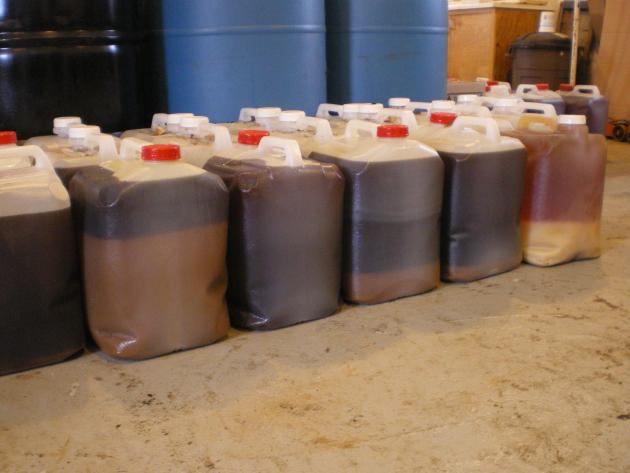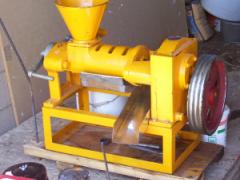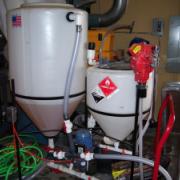Economics of Small-Scale Biodiesel Production
 |
| Canola or rapeseed oil crop. Photo: eXtension Ag Energy. |
Small-scale biodiesel production economics can vary substantially depending on an individual producer’s choice of feedstock, equipment, market, and the value of his or her time. However, several key issues affect all small scale producers.
Oil
Small-scale biodiesel processors may be able to collect oilseeds or waste oil for very little expense. Several common outlets are waste greases from restaurants, animal fats from rendering plants, or damaged grain from mills. Even though the waste oil or seeds may be free, producers still need to account for their time and transportation costs when determining overall profitability. More likely, the oilseeds or oil will have to be purchased if the seeds are not produced at home. The expense of buying oilseeds or oil products for biodiesel production into oil typically accounts for more than 70% of total costs.
Purchasing versus Collecting Oil
Virgin (new) oil purchased from a oilseed crusher or processor tends to be the highest quality, most consistent, and most abundant. However, it also is likely to be the most expensive source of vegetable oil.
 |
| Photo: Richard Wiswall, Cate Farm, Vermont. |
In some areas, an intermediate option is to purchase used oils from companies that collect waste oil from restaurants and other food processing companies. Oils purchased from these companies are usually filtered and separated into various grades of oil before they are resold. These used oils are less expensive than virgin oils but of lower quality and limited in both quantity and geographic availability.
A third option for some small-scale producers is to collect used oils themselves from restaurants in their area. This is usually the cheapest option (no cash payment in many cases). Low-quality oils may require additional filtering and pre-treatment to produce a good-quality biodiesel feedstock. Collecting oil directly from restaurants also requires the largest time investment. Oil supplies might also be highly seasonal depending on restaurant activity.
Finally, many agricultural producers have interest in processing oilseeds they have raised themselves on their farms. While farmers may have minimal cash invested in their crop and the oilseeds appear to be relatively cheap, economists urge them to value their production at full market prices so they can determine the profitability of farm and biodiesel production. Oilseeds that are only produced annually must also be stored if processing does not occur immediately, a factor that adds to total expense.
Why Are Vegetable Oilseed Prices So High?
When small-scale processors begin to explore the economics of biodiesel production, they often find it difficult to purchase oil at a price low enough for profitable production. While vegetable oils historically were quite inexpensive, their value has risen as new applications for their use have evolved. Market speculation may also have driven up the price.
Two of the most significant markets are human consumption and industrial products. Health-conscious consumers have bid up vegetable oil prices for both cooking and consumption. There is a growing industrial market for bio-based composites and plastics that provide consumers with more environmentally friendly and renewable products. These competing demands have led to rising oil market prices. In general, these market opportunities provide higher profit margins than fuel production.
Oilseed Processing
 |
 |
| Sunflower oilseed crop. Photo: Vern Grubinger, University of Vermont Extension. | A 1-ton per day oilseed press before drive belt installation. Photo: Joel Schumacher, Associate Specialist, Agricultural Economics, Montana State University. |
Many small-scale biodiesel processors find that extracting the oils contained in their oilseeds prior to biofuel production improves profitability. This processing generally involves squeezing the seeds with a mechanical press to separate the oil from the meal portion of the seed. Not only is more oil eventually obtained, but the coproduct produced has value as a livestock feed. Given oil removal, the remaining meal has a higher proportion of protein and is therefore more valuable. Again, this product should be valued at market prices, a measure which creates an additional credit and enhances biodiesel profitability. Oil processing expenses include investment costs of the pressing equipment (depreciations, interest, repairs, and insurance) as well as operating costs for fuel, labor, and repairs. Urban biodiesel producers are unlikely to find this option attractive.
Alcohol
The biodiesel production process consumes 11% methanol (by weight) during the transesterification process. However, most producers use between 18% and 22% methanol to ensure a more complete reaction and utilize all of the oils present. This is especially true if the whole oilseed or contaminated waste greases are used. Although commercial biodiesel producers recover the excess methanol and reuse it, few small-scale producers will find it technically and economically feasible. Therefore, in their operations, each gallon of biodiesel produced uses about one-fifth of a gallon of methanol. If methanol costs $3.00 per gallon, then each gallon of biodiesel contains about $0.60 of methanol. An increase or decrease of $1.00 per gallon in the price of methanol changes the production cost of biodiesel by $0.20. Methanol costs are a non-trivial portion of biodiesel production costs.
Catalyst
A catalyst is required to facilitate the reaction between the oil and alcohol. Common catalysts used in small-scale biodiesel production are sodium hydroxide (lye) and potassium methoxide. Small-scale biodiesel producers select a catalyst based on equipment compatibility, functionality, availability, and price. Price is often not the most important factor in selecting a catalyst because it typically contributes only $0.05 to $0.15 to the cost of each gallon of biodiesel produced.
Equipment
Equipment for small-scale biodiesel production is available in many sizes, with varying accessories and different qualities of construction materials. Some systems are quite labor intensive, while others are highly automated, adding to total cost. As a result, estimating prices for a typical small-scale producer is difficult. Some producers purchase ready-to-use systems with prices ranging from a few thousand dollars to well over $20,000. Other producers build their own processors using off-the-shelf parts or from low-cost salvaged parts from unused or obsolete equipment. Their cash expenses may be significantly lower, but labor costs increase as time is needed to assemble and test the system.
 |
| Biodiesel processor: 60 gallons per batch. Photo: Joel Schumacher, Associate Specialist, Agricultural Economics, Montana State University. |
Regardless of how much is spent or what type of system is constructed, small-scale biodiesel processors have several issues to consider.
One key issue is the size of the system. Larger systems tend to cost more than smaller systems but often require similar amounts of time to operate, leading to lower labor costs per gallon of biodiesel produced. For example, a 40-gallon batch processor that requires 3 hours of labor at $10 per hour results in $0.75 of labor costs (3 x $10 = $30 / 40 gallons = $0.75) per gallon of biodiesel. An 80-gallon processor that also requires 3 hours of labor to operate results in $0.38 per gallon (3 x $30 = $30 / 80 gallons = $0.375).
This tradeoff between the size of the processor and the cost of the processor can also be examined by evaluating the fixed costs of a theoretical small-scale biodiesel producer. Assume a biodiesel producer obtains a loan to purchase biodiesel production equipment with annual payments of $1,000 per year for five years. If this system produces 750 gallons annually, the fixed capital costs are $1.33 ($1,000 / 750 gallons) per gallon of biodiesel produced. If the producer increases production to 1,500 gallons per year, the fixed capital costs per gallon are $0.67 ($1,000/1,500).
Another key issue is the life expectancy of the equipment. Most biodiesel systems are designed to last from a few years to 10 or more years. Purchasing a processor with higher quality materials may increase the cost but also increase the number of gallons of biodiesel the equipment can be expected to process during its lifetime. Higher quality may actually lower total capital costs if the system requires less maintenance or delays replacement costs.
A final key issue is the decision to buy a ready-made processor or build a processor. Ready-to-use processors tend to be more expensive but are basically ready to operate the day they are installed. If an individual has access to the low cost parts and labor, has plenty of time and mechanical skill, and is not in a hurry to produce biodiesel, building the system may be both more rewarding and economical. It is important that home-built processors are designed in a way that does not raise safety concerns during construction or operation of the equipment.
One consideration that may influence processors’ decisions to buy or build is their tax situation. While purchased systems are more expensive, individuals in higher tax brackets may find the additional IRS depreciation and investment tax credits to be a significant advantage that sways their decision.
Labor
The economics of small-scale biodiesel production often treat labor costs quite differently. The commonly accepted method of calculating labor costs for commercial ventures is to calculate the number of hours of labor that are required to complete a specific task (or set of tasks), then determine the cost of employing workers to complete these tasks. The cost of labor includes the wages paid to the worker, payroll taxes, and employee benefits (retirement plan contributions, health insurance, etc.). This method is fairly straightforward and simple to estimate.
Small-scale producers, however, typically do all of the work themselves. In most cases, they probably do not track their hours or pay themselves based on an hourly wage. The question becomes how small producers working for themselves place a value on their time. One method is to evaluate the value of other activities the small-scale producer could have been doing instead of producing biodiesel. For example, if a producer could work an additional four hours per week at a part-time job paying $9.00 per hour if he or she was not producing biodiesel, the value of his or her time is $9.00 per hour. However, some small-scale producers treat their biodiesel production as a hobby and do not place a value on their time. All of these may be appropriate methods depending on the individuals’ motivation and goals. Understanding the differences in these methods of valuing the labor costs for small-scale producers can shed some light on widely varying cost estimates of biodiesel production made by different small-scale producers.
Electricity
Producing biodiesel typically requires the use of electric pumps and, in some cases, electric heaters. Electric heaters speed up the transesterification process, which reduces overall investment costs per gallon because more production can be obtained from a fixed plant size. Electricity costs typically contribute only a few cents to the cost of each gallon of biodiesel produced. Producers may also heat the biodiesel to recover methanol. In either case, electricity costs are a small portion of total production costs.
 |
| Biodiesel production set up in a barn. Photo: eXtension Ag Energy. |
Building
Producing biodiesel is typically done in a shop, garage, or other industrial space. Operations that build a separate facility or rent space will have additional costs that need to be attributed to their biodiesel production. Other producers will simply use a portion of an existing building and will not have direct costs attributable to renting space. In either case, producers may have costs for heat, lights, and other utilities. These costs may be significant or nearly zero, depending on the specifics of the operation.
Safety Equipment
Producing biodiesel requires the proper handling of flammable liquids (methanol, vegetable oil, biodiesel, and glycerin) and dangerous chemicals (catalyst and neutralizers) as well as the operation of electrical equipment. To ensure safety, it may be necessary to purchase and use such safety equipment as fire extinguishers, face shields, gloves, aprons, and other equipment. Some of this equipment will be a one-time purchase, while other equipment will need to be replaced on a regular basis. These costs are not likely to be major contributors to the total cost of biodiesel production but should be evaluated.
Related to safety are disposal costs. Small-scale processors may not have readily available markets for their residual materials. One of the more significant is glycerin. Processors may have to pay someone else to transport and dispose of this material which may be classified as hazardous depending on the amount of methanol removed.
Laboratory Equipment
Prior to producing each batch of biodiesel, most producers perform a titration test. The titration test helps producers adjust the catalyst to improve the yield for a successful batch of biodiesel. Special lab equipment (a scale, beakers, etc.) is required to perform these tests. Although most of the equipment is relatively inexpensive, a total investment of $100 to $300 may be required to obtain the proper equipment for titrations.
If production is sold, the producer may also need lab equipment for quality testing to mitigate liability risks. Even if biodiesel produced is used solely onsite, quality testing is still urged. Depending on feedstock source, degree of processing experience, and technology, product quality can vary substantially. To minimize engine filter changes or, even worse, internal damage, producers should test the quality of their biodiesel. Lab equipment for biodiesel quality testing can be very expensive. Small producers generally use the services of a commercial lab for this. The National Biodiesel Board has a short list of labs that comply with their BQ-9000 quality program.
Marketing
One of the most important decisions a prospective small-scale biodiesel operation needs to make early on is whether to produce biodiesel solely for its own consumption or for sale to others. A decision is to increase production and market biodiesel to others will impact the size of the processing facility, costs of securing the market, and liability exposure. As shown above, increasing the quantity of biodiesel produced directly reduces per-gallon investment costs.
Producers intending to market their production will have to prove to purchasers that they can produce biodiesel of sufficient quality and reliability batch after batch. Several quality tests are usually required to evaluate purity, cold flow, and other attributes of interest to the buyer. A related concern is liability exposure. While these tests document the initial quality of the product, they do not remove liability from use later on. Individuals selling biodiesel to others, even friends and neighbors, should strongly consider purchasing liability insurance to protect them from legal claims.
It should also be noted that commercial sales of biodiesel require the producer to be registered with the Environmental Protection Agency, a potentially expensive process.
Finally, small-scale processors who intend to market their production face one last hurdle: that of being a reliable supplier. Marketers generally prefer stability and even-quantity purchases over time. However, the seasonal nature of farm occupations presents a logistical challenge.
Incentives
Numerous government agencies, nonprofit organizations, and other groups offer incentives for biodiesel production. Some of these incentives are grants for equipment purchases, while others are payments based on the quantity of biodiesel produced. These can provide biodiesel producers with both start-up funds and ongoing revenue. It is also worth noting that some of these incentives require substantial paperwork. Not all producers will qualify for every incentive, and not all producers will find it is worth the time and effort to complete the paperwork required for some of the incentives.
Risk Management
Large-scale biodiesel processors have faced a challenging operating environment over the past several years. In fact, commercial production all but ceased in 2009 following the national recession. The immediate future also appears to be highly uncertain given Congress’s failure to restore the Biodiesel Tax Credit.
Small biodiesel processors face these challenges, and maybe even more. First, given their limited historical experience, it is likely that they will face technology challenges during start-up. Second, if their processing is only seasonal, there may be a wider gap between feedstock acquisition and biodiesel use. Market prices of both agricultural commodities and energy fuels are highly volatile and are not perfectly correlated. Therefore, processors may find themselves with a large inventory of expensive feedstock and declining biodiesel prices. The AgRisk Library has a number of useful risk management tools that can be employed to lessen technology and price risks.
Other Issues
Most but not all of the economic issues relevant to small-scale biodiesel have been discussed here. Permitting and glycerin disposal costs may also play a role in the economics of small-scale biodiesel production. There may also be other costs unique to specific situations, depending on individual situations.
Summary
It is difficult to accurately estimate each of these costs for all producers. Free spreadsheets are available from Montana State University to help producers estimate these costs for a specific situation.
Understanding the key economic issues relating to biodiesel production can help potential biodiesel producers make more informed decisions.
More Topics
- Safety in Small-Scale Biodiesel Production
- Safe Chemical Handling in Biodiesel Production
- Biodiesel Production Principles and Processes
- Used and Waste Oil and Grease for Biodiesel
- Oilseed Handling for Biodiesel Production
- Biodiesel Fuel Quality
Additional Resources
- Promise and Pitfalls of Biofuels Jobs An editorial in Biofuels magazine points out that small-scale biofuels production is likely to create more sustainable jobs than large-scale production.
- Farm Scale Biodiesel Production: Taxes and Financial Incentives This webinar from the National Sustainable Agriculture Information Service gives an overview of federal and state financial incentives for biodiesel production. The webinar originally aired on April 8, 2010.
- Introduction to Farm Energy
- Introduction to Biodiesel
- Biodiesel Feedstocks
- Biodiesel Processing
- Biodiesel Utilization
Contributors to This Article
Authors
- Joel Schumacher, Extension Economics Associate Specialist, Montana State University
- Cole Gustafson, North Dakota State University
Peer Reviewers
- Jon Van Gerpen, Professor, Department of Biological and Agricultural Engineering, National Biodiesel Education Program, University of Idaho
- Dev Shrestha, Associate Professor, Department of Biological and Agricultural Engineering, National Biodiesel Education Program, University of Idaho
